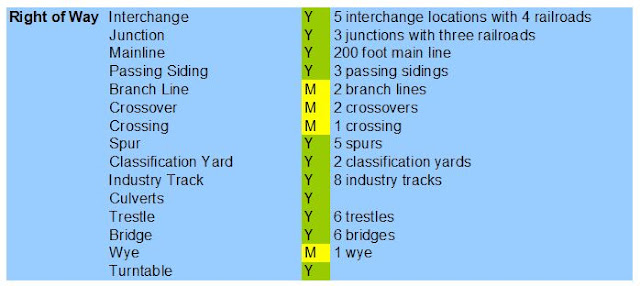Layout Detail. Layout Detail identifies the parameters within which the layout must be designed. It is broken down into two main elements: 5) Layout Design, and 6) Construction to build the railroad.
- Functional capacity of cars in yards and industry.
- Functional capacity of the main line and passing tracks for movement of cars.
Data collection
The unit of measurement for this analysis is Car Capacity (CC) -
the maximum number of 40' cars that can occupy each type of trackage.
Actual footage doesn't work because car clearance requirements, etc.
Each track is identified, measured and the data collected in spreadsheet
format.
Those types of
trackage to be measured were:
- Running trackage (RT): Mainline and branchline trackage over which trains move to get to another part of the system.
- Passing trackage (PT): Main line passing tracks, not within yard limits.
- Maintenance and servicing trackage (MT): all trackage normally occupied by MOW cars, engine facilities, turntables, roundhouse, and similar tracks.
- Storage trackage (ST): the total of Yard trackage (YT), Industrial trackage (IT) - basically all trackage on which equipment is stored when not running.
- Functional trackage (FT): trackage used for maneuvering between all the other elements - yard leads and ladders, passing and runaround tracks, inbound and outbound tracks within yard limits, and interchange tracks.
Upon completion, the modeler has the maximum number of cars that can be physically held on the layout:
(RTc - running trackage car capacity),
(PTc - passing trackage car capacity),
STCc - YTc and ITc),
FTc
Number of cars moved (NCM)
Cars in Service (CIS)
Data Analysis
With this information collected, the following information can be calculated:
Storage Saturation (SS): percentage of
Functional Saturation (FS)
Funcgtional Main Line Saturation (FMLS):
Additional operational information is required for analysis. That information includes:
- Number of Cars in Service
- Number of Cars Moved
- InTransit Car Capacity Eastbound
- InTransit Car Capacity Westbound
Once the data was entered into the database, car density was calculated and compared to a car density baseline suggested by the author.
- Functional Mainline Saturation (25-35%).
- Functional Track Saturation: (40-50%),
- Storage Track Saturation: 33% (80-85%) ** assuming class 1 operations
- Ideal Number of Cars is (30% of Storage tracks filled - Class 3)
The WWSL
An example
Let's use Station 15 - Basalt for the example. Here is the Section diagram.
Measuring in 40' car length's for each track type we get the following data:
The entire WWSL layout.
I did this for the entire WWSL layout. The results were:
My operational information was included:
- Number of Cars in Service - 125
- Number of Cars Moved - 80 (this included OPLC and STC operations)
- InTransit Car Capacity Eastbound - 36 - (this included OPLC reload operations)
- InTransit Car Capacity Westbound - 36 - (this included OPLC reload operations)
WWSL Analysis
Based on the formulas in the spreadsheet, my Track Density for operations were:
- Functional Mainline Saturation (25-35%) - 53% .
- InTransit Car Capacity Eastbound - (25-35%) -27% .
- InTransit Car Capacity Westbound - (25-35%) - 24% .
- Functional Track Saturation: (40-50%) - 25%
- Storage Track Saturation: (80-85%) - 27%
- Ideal Number of Cars: (30%) - 114
- Functional Mainline Saturation (25-35%) - 53% . The WWSL is a Class III railroad and has two additional Class III railroads it provides services to it. The WWSL main line is the means to getting to the customers on the line.
- InTransit Car Capacity Eastbound
- (25-35%) -27%. This includes the OPLC reload (logging shuttle)
operations, some of it on the WWSL main line. Totally consistant with
Class III operations.
- InTransit Car Capacity Westbound - (25-35%) - 24% . Again totally consistant with Class III operations.
- Storage Track Saturation - (80-85%) - 27%. Realizing the 80% is assuming class 1 operations, Class III operations would see primarily empty storage tracks as the norm.
- Ideal Number of Cars - (30%) - 114. I am using off-layout car storage for additional cars (for purposes of car interchange and car model type variety).















